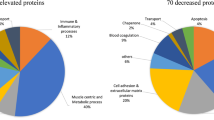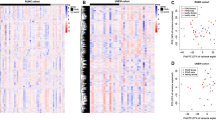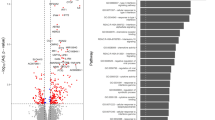Abstract
Though Deflazacort and prednisone improve clinical endpoints in Duchenne muscular dystrophy (DMD) patients, Deflazacort produces fewer side effects. As mechanisms of improvement and side effect differences remain unknown, we evaluated effects of corticosteroid administration on gene expression in blood of DMD patients. Whole blood was obtained from 14 children and adolescents with DMD treated with corticosteroids (DMD-STEROID) and 20 DMD children and adolescents naïve to corticosteroids (DMD). The DMD-STEROID group was further subdivided into Deflazacort and prednisone groups. Affymetrix U133 Plus 2.0 expression microarrays were used to evaluate mRNA expression. Expression of 524 probes changed with corticosteroids, including genes in iron trafficking and the chondroitin sulfate biosynthesis pathway. Deflazacort compared with prednisone yielded 508 regulated probes, including many involved in adipose metabolism. These genes and pathways help explain mechanisms of efficacy and side effects of corticosteroids, and could provide new treatment targets for DMD and other neuromuscular disorders.
This is a preview of subscription content, access via your institution
Access options
Subscribe to this journal
Receive 6 print issues and online access
$259.00 per year
only $43.17 per issue
Buy this article
- Purchase on Springer Link
- Instant access to full article PDF
Prices may be subject to local taxes which are calculated during checkout



Similar content being viewed by others
References
Hoffman EP, Brown Jr RH, Kunkel LM . Dystrophin: the protein product of the Duchenne muscular dystrophy locus. Cell 1987; 51: 919–928.
Acharyya S, Villalta SA, Bakkar N, Bupha-Intr T, Janssen PM, Carathers M et al. Interplay of IKK/NF-kappaB signaling in macrophages and myofibers promotes muscle degeneration in Duchenne muscular dystrophy. J Clin Invest 2007; 117: 889–901.
Manzur AY, Kuntzer T, Pike M, Swan A . Glucocorticoid corticosteroids for Duchenne muscular dystrophy. Cochrane Database Syst Rev 2004, 1: CD003725.
Griggs RC, Moxley III RT, Mendell JR, Fenichel GM, Brooke MH, Pestronk A et al. Duchenne dystrophy: randomized, controlled trial of prednisone (18 months) and azathioprine (12 months). Neurology 1993; 43: 520–527.
Haslett JN, Sanoudou D, Kho AT, Han M, Bennett RR, Kohane IS et al. Gene expression profiling of Duchenne muscular dystrophy skeletal muscle. Neurogenetics 2003; 4: 163–171.
Raju R, Dalakas MC . Gene expression profile in the muscles of patients with inflammatory myopathies: effect of therapy with IVIg and biological validation of clinically relevant genes. Brain 2005; 128: 1887–1896.
Wong B, Gilbert DL, Walker WL, Liao IH, Lit L, Stamova B et al. Gene expression in blood of subjects with Duchenne muscular dystrophy. Neurogenetics 2008.
Ward PP, Paz E, Conneely OM . Multifunctional roles of lactoferrin: a critical overview. Cell Mol Life Sci 2005; 62: 2540–2548.
Baynes RD, Bezwoda WR, Khan Q, Mansoor N . Plasma lactoferrin content: differential effect of steroid administration and infective illnesses: lack of effect of ambient temperature at which specimens are collected. Scand J Haematol 1986; 37: 353–359.
Ratledge C . Iron metabolism and infection. Food Nutr Bull 2007; 28: S515–S523.
Borregaard N, Cowland JB . Neutrophil gelatinase-associated lipocalin, a siderophore-binding eukaryotic protein. Biometals 2006; 19: 211–215.
Mori K, Nakao K . Neutrophil gelatinase-associated lipocalin as the real-time indicator of active kidney damage. Kidney Int 2007; 71: 967–970.
Nicholson H, Anderson BF, Bland T, Shewry SC, Tweedie JW, Baker EN . Mutagenesis of the histidine ligand in human lactoferrin: iron binding properties and crystal structure of the histidine-253-->methionine mutant. Biochemistry 1997; 36: 341–346.
Yang J, Goetz D, Li JY, Wang W, Mori K, Setlik D et al. An iron delivery pathway mediated by a lipocalin. Mol Cell 2002; 10: 1045–1056.
Liu QS, Nilsen-Hamilton M, Xiong SD . Synergistic regulation of the acute phase protein SIP24/24p3 by glucocorticoid and pro-inflammatory cytokines. Sheng Li Xue Bao 2003; 55: 525–529.
Garay-Rojas E, Harper M, Hraba-Renevey S, Kress M . An apparent autocrine mechanism amplifies the dexamethasone- and retinoic acid-induced expression of mouse lipocalin-encoding gene 24p3. Gene 1996; 170: 173–180.
Schaer DJ, Alayash AI, Buehler PW . Gating the radical hemoglobin to macrophages: the anti-inflammatory role of CD163, a scavenger receptor. Antioxid Redox Signal 2007; 9: 991–999.
Martinez-Subiela S, Ginel PJ, Ceron JJ . Effects of different glucocorticoid treatments on serum acute phase proteins in dogs. Vet Rec 2004; 154: 814–817.
Ting ST, Earley B, Crowe MA . Effect of cortisol infusion patterns and castration on metabolic and immunological indices of stress response in cattle. Domest Anim Endocrinol 2004; 26: 329–349.
Yamazaki H, Ohta K, Tsukiji H, Toma T, Hashida Y, Ishizaki A et al. Corticosteroid enhances heme oxygenase-1 production by circulating monocytes by up-regulating hemoglobin scavenger receptor and amplifying the receptor-mediated uptake of hemoglobin-haptoglobin complex. Biochem Biophys Res Commun 2007; 358: 506–512.
Schaer DJ, Boretti FS, Schoedon G, Schaffner A . Induction of the CD163-dependent haemoglobin uptake by macrophages as a novel anti-inflammatory action of glucocorticoids. Br J Haematol 2002; 119: 239–243.
Sokolov AV, Pulina MO, Ageeva KV, Runova OL, Zakharova ET, Vasil'ev VB . Identification of leukocyte cationic proteins that interact with ceruloplasmin. Biochemistry (Mosc) 2007; 72: 872–877.
Healy J, Tipton K . Ceruloplasmin and what it might do. J Neural Transm 2007; 114: 777–781.
Bornman L, Rossouw H, Gericke GS, Polla BS . Effects of iron deprivation on the pathology and stress protein expression in murine X-linked muscular dystrophy. Biochem Pharmacol 1998; 56: 751–757.
Fadic R, Mezzano V, Alvarez K, Cabrera D, Holmgren J, Brandan E . Increase in decorin and biglycan in Duchenne Muscular Dystrophy: role of fibroblasts as cell source of these proteoglycans in the disease. J Cell Mol Med 2006; 10: 758–769.
Hutchison CJ, Yasin R . Altered secretion of chondroitin sulfate proteoglycan in Duchenne muscular dystrophy cultures. J Neurol Sci 1987; 79: 77–81.
Fisher I, Abraham D, Bouri K, Hoffman EP, Muntoni F, Morgan J . Prednisolone-induced changes in dystrophic skeletal muscle. FASEB J 2005; 19: 834–836.
Baughman G, Wiederrecht GJ, Chang F, Martin MM, Bourgeois S . Tissue distribution and abundance of human FKBP51, and FK506-binding protein that can mediate calcineurin inhibition. Biochem Biophys Res Commun 1997; 232: 437–443.
Serrano AL, Murgia M, Pallafacchina G, Calabria E, Coniglio P, Lomo T et al. Calcineurin controls nerve activity-dependent specification of slow skeletal muscle fibers but not muscle growth. Proc Natl Acad Sci USA 2001; 98: 13108–13113.
Subramaniam M, Hawse JR, Johnsen SA, Spelsberg TC . Role of TIEG1 in biological processes and disease states. J Cell Biochem 2007; 102: 539–548.
Yeamans C, Wang D, Paz-Priel I, Torbett BE, Tenen DG, Friedman AD . C/EBPalpha binds and activates the PU.1 distal enhancer to induce monocyte lineage commitment. Blood 2007; 110: 3136–3142.
Georgopoulos K, Bigby M, Wang JH, Molnar A, Wu P, Winandy S et al. The Ikaros gene is required for the development of all lymphoid lineages. Cell 1994; 79: 143–156.
Redonnet A, Bonilla S, Noel-Suberville C, Pallet V, Dabadie H, Gin H et al. Relationship between peroxisome proliferator-activated receptor gamma and retinoic acid receptor alpha gene expression in obese human adipose tissue. Int J Obes Relat Metab Disord 2002; 26: 920–927.
Xue JC, Schwarz EJ, Chawla A, Lazar MA . Distinct stages in adipogenesis revealed by retinoid inhibition of differentiation after induction of PPARgamma. Mol Cell Biol 1996; 16: 1567–1575.
Molero JC, Jensen TE, Withers PC, Couzens M, Herzog H, Thien CB et al. c-Cbl-deficient mice have reduced adiposity, higher energy expenditure, and improved peripheral insulin action. J Clin Invest 2004; 114: 1326–1333.
Zhang Y, Schmidt RJ, Foxworthy P, Emkey R, Oler JK, Large TH et al. Niacin mediates lipolysis in adipose tissue through its G-protein coupled receptor HM74A. Biochem Biophys Res Commun 2005; 334: 729–732.
Ge H, Li X, Weiszmann J, Wang P, Baribault H, Chen JL et al. Activation of GPR43 in adipocytes leads to inhibition of lipolysis and suppression of plasma free fatty acids. Endocrinology 2008.
Picard F, Gehin M, Annicotte J, Rocchi S, Champy MF, O'Malley BW et al. SRC-1 and TIF2 control energy balance between white and brown adipose tissues. Cell 2002; 111: 931–941.
Strandberg L, Mellstrom D, Ljunggren O, Grundberg E, Karlsson MK, Holmberg AH et al. IL6 and IL1B polymorphisms are associated with fat mass in older men: the MrOS Study Sweden. Obesity (Silver Spring) 2008; 16: 710–713.
Thach DC, Lin B, Walter E, Kruzelock R, Rowley RK, Tibbetts C et al. Assessment of two methods for handling blood in collection tubes with RNA stabilizing agent for surveillance of gene expression profiles with high density microarrays. J Immunol Methods 2003; 283: 269–279.
Tibshirani R, Hastie T, Narasimhan B, Chu G . Diagnosis of multiple cancer types by shrunken centroids of gene expression. Proc Natl Acad Sci USA 2002; 99: 6567–6572.
Dennis Jr G, Sherman BT, Hosack DA, Yang J, Gao W, Lane HC et al. DAVID: database for annotation, visualization, and integrated discovery. Genome Biol 2003; 4: P3.
Acknowledgements
We thank the nurses and study coordinators who helped with these studies at Cincinnati Children's Hospital Medical Center. We also thank the Affymetrix cores for processing the samples. This study was supported by NIH/NINDS Grants (NS043252 and NS056302, FRS), support from Cincinnati Children's Hospital Medical Center (BW), and support from the M.I.N.D. Institute at the University of California at Davis (FRS, LL, IL, WW, MA).
Author information
Authors and Affiliations
Corresponding author
Additional information
Supplementary Information accompanies the paper on the The Pharmacogenomics Journal website (http://www.nature.com/tpj)
Supplementary information
Rights and permissions
About this article
Cite this article
Lit, L., Sharp, F., Apperson, M. et al. Corticosteroid effects on blood gene expression in Duchenne muscular dystrophy. Pharmacogenomics J 9, 411–418 (2009). https://doi.org/10.1038/tpj.2009.22
Received:
Revised:
Accepted:
Published:
Issue Date:
DOI: https://doi.org/10.1038/tpj.2009.22
Keywords
This article is cited by
-
Forward subtractive libraries containing genes transactivated by dexamethasone in ataxia-telangiectasia lymphoblastoid cells
Molecular and Cellular Biochemistry (2014)



